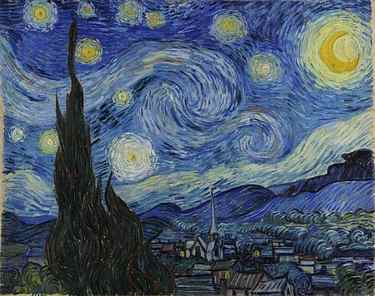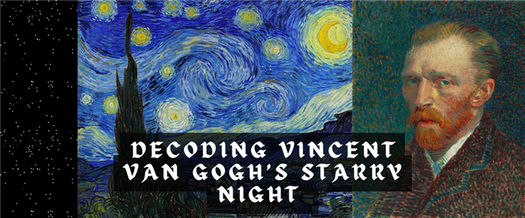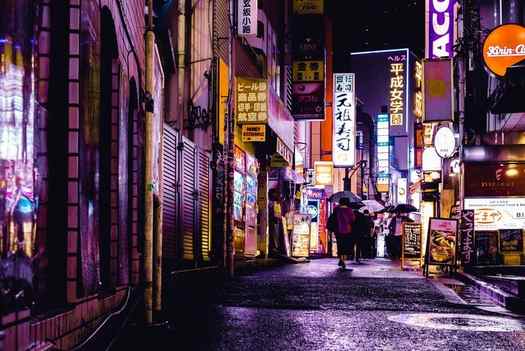2020-02-25
Vincent van Gogh’s ‘Starry Night’ Has Captivated the Public for Over a Century—Here Are 3 Things You Might Not Know About It
The artist’s magnum opus has spawned a cottage industry of sleuths and interpreters.

Vincent van Gogh’s The Starry Night (1889) is art history’s most famous celestial scene—and one of the world’s most beloved paintings to boot (the phenomenon of the immersive Van Gogh experience seems to prove people want not just to look at it, but to be inside it, too).
It’s not hard to see why. The Post-Impressionist masterpiece hums with a swirling internal energy all its own. In the foreground of the painting, a cypress tree flares up against a night sky that reverberates with dazzling shades of blue. Van Gogh conjures a sky that isn’t static and distant, but alive and moving, and the stars and moon glow with rings of luminous yellow. Below this brilliant night sky, a village sleeps quietly, seemingly wrapped in the protection of the heavens, a lone church steeple straining upwards to touch them.
Aside from its formal qualities, a lore has built up around the painting, due largely to the circumstances surrounding its creation. Van Gogh made The Starry Night at Saint-Paul-de-Mausole asylum in Saint-Rémy, in southern France, where he had voluntarily admitted himself following a manic episode in which he infamously mutilated his own ear. Many have interpreted the painting as Van Gogh’s contemplation of his own mortality—the cypress tree was a common symbol of death and mourning, and the artist often affiliated the stars with the afterlife. In one letter to his brother Theo, he wrote, “ But the sight of the stars always makes me dream… Why, I say to myself, should the spots of light in the firmament be less accessible to us than the black spots on the map of France? Just as we take the train to go to Tarascon or Rouen, we take death to go to a star.”
But while the artist’s masterpiece certainly lends itself to emotive interpretations, it was also the highly considered result of one of the most productive periods of his career. The Saint-Paul-de-Mausole asylum was a progressive institution in which patients were encouraged to spend time in nature, and the artist’s brother ensured his brother was given a studio and ample time to paint.
There, in the shrouded safety of the asylum, Van Gogh experienced some of his most brilliant—and peaceful—moments. He painted his famous Irises within his first several days there, and he would go on to paint The Starry Night over just a few days in June of 1889.
In spite of the painting’s ubiquity in popular culture, The Starry Night is still full of wonderful surprises that have either been overlooked or misunderstood. We’ve found three fascinating facts that just might make you see it differently.
Van Gogh Painted The Starry Night During the Daytime—And Took Some Artistic License With the Cosmos

The gardens of the monastery of Saint-Paul-de-Mausole psychiatric hospital, as seen from a cell, Saint-Remy-de-Provence, France. Photo: Albert Ceolan/De Agostini Picture Library via Getty Images.
One common misconception is that Van Gogh painted his magnum opus while looking out the window from his room in the asylum. While perhaps less romantic a vision, the artist in fact had a separate painting studio at Saint-Paul-de-Mausole where he worked during the day. This studio had no windows at all. Van Gogh did, however, make sketches from his bedroom window, and in The Starry Night, one does see the sloping hills of the Alpilles, a low mountain range, visible from his room.
All in all, however, the scene is a composite of accurate and invented attributes. Van Gogh inserted the view of the village, for instance, and taken similar liberties with the sky. Some details are historically accurate: The bright orb at the center-left of the painting has been identified by astronomers as the the planet Venus, which would have been particularly bright in the summer of 1889. Constellations including Capella, Cassiopeia, and Pegasus are also correctly positioned, with some astronomers having gone so far as to identify the celestial scene as taking place at 4 a.m. on June 19, 1889. However, just as with his depiction of the village, Van Gogh did take a bit of creative license. The moon is shown in the crescent phase, however, it would have been in the less evocative waning gibbous phase at the time he painted it.
Its Radiance Is an Optical Illusion
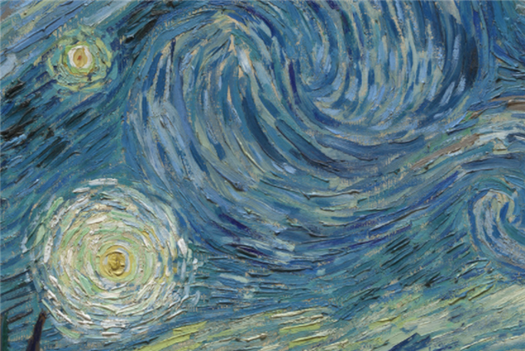
Detail of The Starry Night (1889).
While Van Gogh is often portrayed as the quintessence of the lonely, tortured artist, he was anything but disconnected from contemporary conversations about the latest developments in the arts. His discursive letters to his friends Paul Gaugin and Émile Bernard discussed the latest color theories, including the principles of color contrasts that Van Gogh derived from his hero, the Neoclassical artist Eugène Delacroix.
In 1889, he wrote to Theo about his recent paintings, “When you see them some time […] I shall be able to give you a better idea of the things Gauguin, Bernard and I often used to talk about and occupy ourselves with than I can do in words; it is not a return to Romanticism or to religious ideas, no. But via Delacroix one can express more of Nature and the country, by means of color and an individual drawing style, than might appear.”
For Van Gogh, color was a vehicle for expressing emotion, and the brilliantly hued canvases of his late career succeed in large part to the availability of new hues of paint on the market. It is the intensity of light in those colors on the canvas that gives The Starry Night its unique glow. The contrasts between dashes of paint create an optical effect known as luminance, in which the brain experiences two simultaneous and competing sensory impulses. Simply put—one part of the brain focuses on light and motion, but sees color less distinctly. Another part of the brain, however, will perceive each of the contrasting colors. Van Gogh’s bold, light-filled brushstrokes signal both of these experiences, creating the flickering sense for which the painting is so famed.
Behind the Art: What makes ‘The Starry Night’ by Vincent van Gogh so iconic?
Written by Khyati Rajvanshi New Delhi | Updated: July 3, 2022 20:20 IST
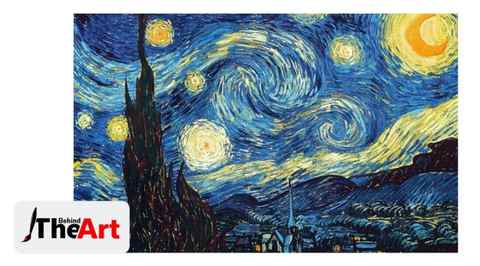
The artist, like many others, gained popularity after his death, making The Starry Night an epitome of modern art mixed with the Post-Impressionism movement. (Photo: Pixabay)
The Starry Night — three words that describe a timeless and magnificent painting done by the Dutch artist Vincent van Gogh in 1889. A painting that became an overnight sensation and immortalised a painter who was not only known for his work but his mental health deterioration, which led to him cutting off his ear and eventually dying by suicide. Much has been said about this painting, which now hangs permanently in the Museum of Modern Art, New York City, and is worth billions of dollars. Is it the story behind this painting that makes it so special or the art itself that speaks great volumes?
A painting by a ‘tortured’ artist
Known as a ‘tortured’ artist, Van Gogh was not so famous during his lifetime. When he painted The Starry Night , he was staying in Saint-Paul-de-Mausole mental asylum in Saint-Rémy-de-Provence in the southern parts of France. He had admitted himself to the asylum after he cut his ear off during an argument with his fellow Post-Impressionist painter Paul Gauguin. During his stay at the asylum, he got two rooms — one was his bedroom, the other a painting studio. He produced several paintings based on the view from his window and the surrounding gardens. His room had a view of the French Alpilles mountain range, which inspired a lot of his landscape paintings. The dark spires in the foreground of the painting depict cypress trees. The trees are usually associated with death and cemeteries, and in some cultures, they symbolise the life of the soul after death. Some people even say a cypress tree reaching the sky means sending the soul to an afterlife. During this time, Van Gogh experienced intense psychotic episodes, and he considered this painting a complete failure.
Advertisement
The painting was eventually taken by his brother. It is said he painted this piece under the influence of treatment drugs for his manic episodes and that he was hallucinating throughout the process. According to pathologist Paul Wolf, Van Gogh’s fondness for yellow in paintings like The Starry Night resulted from taking too much digitalis, a treatment in his day for epilepsy.
Contrary to what people believe, the painting does not reflect his deteriorating mental state. It is known that painting was the only thing that helped him get better which is why his brother insisted he had his painting studio at the asylum. Van Gogh is also known to have loved to paint the night sky. As an admirer and student of astronomy, he liked studying the position of stars and planets through his artwork. This can be seen in the famous The Starry Night painting.

Van Gogh is also known to have loved to paint the night sky. As an admirer and student of astronomy, he liked studying the position of stars and planets through his artwork. (Photo: Pixabay)
The Starry Night
Apart from astronomy, Van Gogh was heavily influenced by the Japanese art style. The Starry Night is a matter of swirls. If you look at the brushstrokes in the painting, they are flowing and are made in circular lines. Some brushstrokes even look like great waves in the sky. This was inspired by The Great Wave by Hokusai. Van Gogh creates a sense of movement with choppier white lines as the sky meets the mountains in the background. He also made use of contrasting colours to create more movement. Each star and the moon has an aura of yellow and white surrounding them. He then uses darker hues of blue to create the contrast. A big part of the painting is the village with a church as the central focal point. This village did not exist in real life and was just a fragment of Van Gogh’s imagination. It is said he could have made the church from his childhood memories as the architecture of it resonates more with the churches found in The Netherlands. He was known to have a religious streak in him and thus several people believe this painting has subliminal religious messages. The eleven stars in the sky, for example, could depict the story of Joseph in the Bible’s Old Testament.
Advertisement
ALSO READ | Behind the Art: Why Edvard Munch’s ‘The Scream’ is considered as an icon of modern art
Impact of the painting in recent times
Most Read
See More
For a painter who painted over 800 oil paintings and sold only one in his lifetime, Van Gogh thought of Starry Night as a ‘failure’; but it would shake up the modern world like a tsunami. Be it the intriguing story of the artist or the art techniques used at that time, this painting still resonates with art lovers across the world. The artist, like many others, gained popularity after his death, making The Starry Night an epitome of modern art mixed with the Post-Impressionism movement. Those studying art or who simply like to look at artworks can appreciate the composition of the painting with the celestial swirls, stylised stars, a crescent and radiating moon. The painting has also become a well-known symbol of expressionism. Starry Night showcases the vast power of nature and the church spire and cypress tree — representing man and nature — both point to the heavens.
Next Up in Behind the Art: Why is The Weeping Woman by Picasso considered an icon of Cubism Movement?
Also Read

Advertisement
For more lifestyle news, follow us on Instagram | Twitter | Facebook and don’t miss out on the latest updates!
Looking into The Starry Night

One of the first things the viewer notices about The Starry Night is the swirling, dreamlike sky. The viewer’s eye naturally follows these whirls, punctuated by clusters of yellow circles surrounded by a white glow. The rolling swirls in the sky give the piece a fluidity, and a sense of continuity. To achieve this effect, he used a loaded brush to create an impasto texture, which means the texture is applied heavily onto the canvas, leaving the brushstrokes and paint-knife marks visible (a feature evident in much of Van Gogh’s work). This technique gave the artwork an expressive quality, one that was in line with his work as an impressionist.
The vivid colors in The Starry Night also suggest emotion rather than realism. Although it has been argued that Van Gogh could have been suffering from lead poisoning late in his life, causing him to choose rather odd colors in his pieces, it seems likely that he was representing the night sky in a way that was particular to him. In a letter to his sister Wilhemien, Van Gogh wrote:
“It often seems to me that the night is even more richly colored than the day, colored with the most intense violets, blues, and greens. If you look carefully, you’ll see that some stars are lemony, others have a pink, green, forget-me-not blue glow. And without laboring the point, it’s clear to paint a starry sky, it’s not nearly enough to put white spots on blue-black.”
Although the colors don’t quite blend together, the broken effect means that the viewer’s gaze is constantly jumping from rich Prussian blue, to cobalt, to ultramarine, intercepted by the deep Indian yellow of the moon and the bright cadmium yellow surrounding the stars. It’s a wonderful effect that gives the piece a sense of vibrancy and movement.
What does it mean?
Of course, given the artwork’s tragic backstory, there are numerous interpretations about what could have been going through Van Gogh’s mind when he created The Starry Night. One of the most striking parts of The Starry Night is the curved, black cypress tree at the right of the piece. Cypress trees are commonly associated with cemeteries and death, and perhaps the prominence of the tree in the piece was intended to symbolize Van Gogh’s depressed mental state.
The cypress tree has an almost threatening presence over the still, calm town. Spanning almost the entire height of the canvas, it has been interpreted as a link between life (the town and the landscape) and death (the sky). Van Gogh was intrigued by the topic of death, writing, “Just as we take the train to go to Tarascon or Rouen, we take death to go to a star.”
Although Van Gogh denied that The Starry Night had any religious meaning, critics have argued that it may show some subliminal religious messages. In particular, it has been argued that The Starry Night could be associated with the Bible quote Genesis 37:9, which reads, “And he dreamed yet another dream, and told it his brethren, and said, Behold, I have dreamed a dream more; and behold the sun and the moon and the eleven stars made obeisance to me.” These critics have also stated that the visibility of the church spire was a clear reference to van Gogh’s religious upbringing.
Interpretations about the meaning of The Starry Night fall pretty divide into two trains of thought. First, that it was a message of hope; although things may appear dark, there will always be something to light the darkness. To expand on this ‘positive’ interpretation, it has also been said that The Starry Night could be symbolic of Van Gogh becoming at peace with the idea of death and accepting his ascension into heaven.


However, other interpretations paint a far darker picture. This argument states that The Starry Night is a depiction of van Gogh’s deteriorating mental state, and the swirling sky echoed the chaos in his mind (van Gogh was believed to suffer from epileptic fits while at the asylum in addition to depression). The presence of the cypress tree, then, is something ominous, a beacon of the end of van Gogh’s life.
Maybe even Van Gogh himself did not know exactly what inspired The Starry Night, as he wrote to Theo, “I don’t know anything with certainty, but seeing the stars makes me dream.”
If you need some inspiration to find your next masterpiece browse our artworks by categories! Do you prefer oil painting, abstract painting or street art painting?
How to Resell an Artwork
My Hometown: BerriBlue
You May Also Like

Green Violinist (1924): Marc Chagall’s Avant-Garde Style

2020-02-25
Female Artists That Made History Through the Ages

2021-03-03



